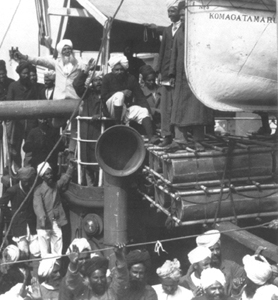
|
Professor Teja Singh led deputations to many levels of government, including Ottawa, where he explained to the Immigration
Department that he represented over 5, 000 East Indian males in British Columbia, who desired to have their wives and
children join them. The Sikhs’ prime concern was the breakup of their traditional family unit. They pleaded with the authorities
to allow their families to join them, but met with no success. As Samuel Raj wrote in 1980:
Three prominent Sikhs, all directors of the trust company, left for India in 1910 promising to return with their families. They were Bhag Singh, Balwant Singh and Hakim Singh Hundal. They left India with their families a year later. When they landed in Hong Kong, the men were allowed to go on to Canada, but their families were detained in Hong Kong by the Canadian Immigration Office. Hakim’s mother, Bishan Kaur, and his four sons, Atma, Iqbal, Teja, and Jermeja -all of Hakim’s family, as he was a widower - spent two years living in the Hong Kong Sikh Temple awaiting immigration clearance to land in Canada. All three families eventually arrived in Canada in 1913 after a barrage of appeals to all levels of government. But the Act of
This set the scene for the infamous Komagata Maru incident in 1914. Since immigrants were required to come to Canada via continuous passage, but there was no direct passage available from India to Canada at this time, an enterprising Sikh businessman named Gurdit Singh chartered a Japanese freighter, the Komagata Maru, to challenge Canadian immigration laws, which discriminated against Indians immigrants. Picking up passengers along the way in Hong Kong, Shanghai and Yokohama, Gurdit Singh arrived in Vancouver with 376 Sikhs on May 23, 1914. The ship also contained a cargo of coal loaded in Japan, which was to be sold here in Canada. The immigration department would not let the ship dock, so it was anchored in the harbor. It was not long before the Khalsa Diwan Society got involved in the dispute. This society, an organization founded in 1907 to manage the affairs of the Vancouver gurdwara and later the other temples, represented the Sikhs in Canada, acting on their behalf in matters that involved any agency outside the community. Officials of the Society and Sikhs from the local temple appealed to the government’s sense of justice, asking that the immigrants be allowed to land. The Vancouver Sikh community even promised to pay the required $200 per person. But the authorities would not relent. Only twenty-two Sikhs, all former residents of Canada, were allowed to land. |
cont...







